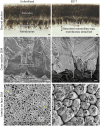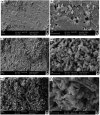Application of the synergism between eggshells and copper in nanotechnology
- PMID: 40417167
- PMCID: PMC12101130
- DOI: 10.1039/d5na00400d
Application of the synergism between eggshells and copper in nanotechnology
Abstract
Eggshells, the non-edible part of an egg, have immense uses in nanotechnology. Copper being an inexpensive metal has versatile applications in nanotechnology. However, its susceptibility to oxidation limits its practical applications. Eggshells are an efficient candidate to synthesize cap copper nanoparticles and copper nanoclusters, which are used in various arenas (dye degradation, antibacterial activity, nitrophenol adsorption, copper adsorption, and sensing). Reports on the edible part of an egg for passivating copper nanoparticles are rare. Usually, chicken eggshells are mostly used in this regard. Moreover, eggshells can be used for the adsorption of ionic copper. Thus, the synergism between eggshells and copper is a very pivotal aspect. The use of biological waste in association with copper in various applications may open a new pathway towards the circular economy. This review article summarizes applications that evolved from copper-eggshell synergism.
This journal is © The Royal Society of Chemistry.
Conflict of interest statement
There is no competing interest to disclose.
Figures

















References
-
- Mottet A. Tempio G. Global Poultry Production: Current State and Future Outlook and Challenges. World's Poult. Sci. J. 2017;73:245–256. doi: 10.1017/S0043933917000071. - DOI
-
- Park S. Choi K. S. Lee D. Kim D. Lim K. T. Lee K.-H. Seonwoo H. Kim J. Eggshell membrane: Review and impact on engineering. Biosyst. Eng. 2016;151:446–463. doi: 10.1016/j.biosystemseng.2016.10.014. - DOI
Publication types
LinkOut - more resources
Full Text Sources
Miscellaneous

